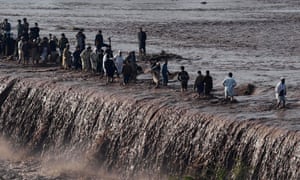With cascading crises – where one event triggers another – set to rise, international disaster risk reduction efforts are woefully underfunded

The world’s failure to prepare for natural disasters will have “inconceivably bad” consequences as climate change fuels a huge increase in catastrophic droughts and floods and the humanitarian crises that follow, the UN’s head of disaster planning has warned.
Last year, earthquakes, floods, heatwaves and landslides left 22,773 people dead, affected 98.6 million others and caused $66.5bn (£47bn) of economic damage (pdf). Yet the international community spends less than half of one per cent of the global aid budget on mitigating the risks posed by such hazards.
Robert Glasser, the special representative of the secretary general for disaster risk reduction, said that with the world already “falling short” in its response to humanitarian emergencies, things would only get worse as climate change adds to the pressure.
He said: “If you see that we’re already spending huge amounts of money and are unable to meet the humanitarian need – and then you overlay that with not just population growth … [but] you put climate change on top of that, where we’re seeing an increase in the frequency and severity of natural disasters, and the knock-on effects with respect to food security and conflict and new viruses like the Zika virus or whatever – you realise that the only way we’re going to be able to deal with these trends is by getting out ahead of them and focusing on reducing disaster risk.”
Failure to plan properly by factoring in the effects of climate change, he added, would result in a steep rise in the vulnerability of those people already most exposed to natural hazards. He also predicted a rise in the number of simultaneous disasters.
“As the odds of any one event go up, the odds of two happening at the same time are more likely. We’ll see many more examples of cascading crises, where one event triggers another event, which triggers another event.”
Glasser pointed to Syria, where years of protracted drought led to a massive migration of people from rural areas to cities in the run-up to the country’s civil war. While he stressed that the drought was by no means the only driver of the conflict, he said droughts around the world could have similarly destabilising effects – especially when it came to conflicts in Africa.
“It’s inconceivably bad, actually, if we don’t get a handle on it, and there’s a huge sense of urgency to get this right,” he said. “I think country leaders will become more receptive to this agenda simply because the disasters are going to make that obvious. The real question in my mind is: can we act before that’s obvious and before the costs have gone up so tremendously? And that’s the challenge.”

Facebook Twitter Pinterest
But Glasser, speaking ahead of next month’s inaugural world humanitarian summit in Istanbul, said international disaster risk reduction (DRR) efforts remain woefully underfunded.
According to UN figures, in 2014 just 0.4% of the global aid budget of $135.2bn – roughly $540m – was spent on DRR. Glasser said the UN wanted that proportion to rise to at least 1% and would push for an increase at the Istanbul meeting.
“That would still be a very small amount of money to meet the problem and that is a big challenge,” he said.
“I used to work for a company that used to say, ‘Once we get a little more money in, we’ll start spending more of it on training our staff. But it’s too tight this year; maybe next year.’ This is one of those things like capacity-building with people: you have to start doing it. You can’t wait. You just have to make choices.”
He said that the internationally agreed Sendai framework for disaster risk reduction, which was adopted last year, offered the best way to reduce the human and financial cost of disasters.
“It’s basically about beginning to think of disaster risk as a core planning activity so that when countries invest in infrastructure they’re not building a hospital in a flood zone or establishing communities in areas vulnerable to storm surges and are not creating risk but identifying ways of reducing it,” he said.
“That’s the only way that I can imagine we’re going to be able to cope at all and even then, it’s a huge challenge to do that.”
The special representative said that DRR simply could not be seen as an adjunct of development or humanitarian relief: they were all part of the same structure. He said that in countries such as Bangladesh, which regularly experiences devastating floods, thousands of lives had been saved over recent decades because DRR had been factored into core economic planning and money invested in infrastructure, storm shelters and early warning systems.
Last year’s earthquake in Nepal was another case in point – and an example of the need for a more holistic approach to development and DRR.
“If you take Nepal, there was a school safety programme that retro-fitted something like 350 to 400 schools to be prepared for earthquakes. As I understand it, not one of those schools collapsed or was damaged significantly during the earthquake,” said Glasser.
“So this is a great example of the links between sustainable development and risk reduction. There’s something like 35,000 public and private schools in that country. If you build them and they’re not earthquake-resilient, and tens of thousands of them are destroyed, it just highlights that you need to get it right the first time if you’re going to achieve a development outcome like improving literacy or the education of girls.”
Dr Matthias Garschagen, scientific director of the World Risk Report (pdf), said large-scale disasters such as the earthquakes in Nepal and Haiti often act as stark reminders of fundamental development problems.
Advertisement
“Nepal, in a very sad fashion, reminded us of the importance of infrastructure for humanitarian assistance,” he said. “Nepal is a country that is very challenged by its geography and has very limited road and rail networks; there wasn’t the helicopter infrastructure in place to distribute humanitarian assistance in a sufficient manner.”
He said the 2010 earthquake in Haiti – which is estimated to have killed between 90,000 and 316,000 people and displaced more than 1.5 million – served as a warning of the need for building codes, and for health and sanitation plans to deal with the aftermath of a disaster.
But although international attention is quick to focus on huge disasters and lessons are often learned, Garschagen says the momentum is not always sustained.
A recent trip to Indonesia, he said, had yielded evidence of a familiar post-disaster pattern.
“After the Indian Ocean tsunami there was a lot of attention and international resourcing into building tsunami resilience.
“The tsunami early warning system worked well for three or four years – and worked well institutionally – but afterwards, it started to fade so the equipment hasn’t been well maintained and the institutional capacity-building was not kept alive. In educational terms, the topic [has] faded out of awareness.”
And therein, he added, lies the challenge: “Every time there’s a mega disaster, there are lessons learned – or at least there’s a lot of attention in the scientific and political realm. The key question is always, how do you keep up the awareness after a couple of years?”

